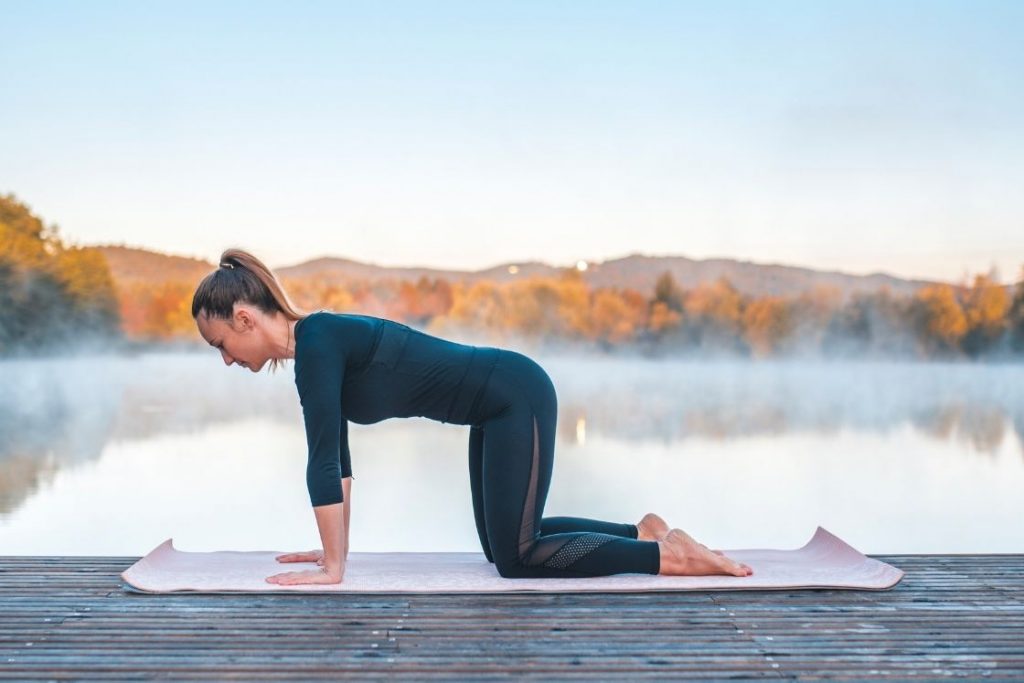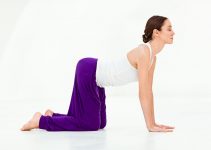
Table Top Pose is a beginner restorative pose from which you transition into many balancing poses such as the plank pose, tiger pose, downward dog pose, cat/cow pose, child’s pose, etc.
The pose is quite beneficial to people who are new to yoga and are in the process of understanding their bodies. It strengthens the wrist, arms and shoulders muscles, therefore, can be used as a warm-up exercise before yoga. Moreover, tabletop can be a relaxing posture in vinyasa while transitioning from one pose to another. It will help increase your prana level and find balance and stability.
keep on reading to know the benefits of table top pose, how to do it and more.
Bharmanasana Meaning
Table Top Pose is called Bharmanasana in Sanskrit. Bharma means ‘table or board to hold something’ and Asana means ‘pose’. The back of the body in Bharmanasana comes in a flat position, similar to a table or board, therefore it’s called tabletop pose.
While practising this pose, all your muscles get stretched and your core also gets strengthened to a significant level. This is a preparatory pose where you can find your balance and learn to engage your core muscles for more intermediate and advanced poses.
Practice Guide of Table Top Pose
Let us have a look at some precautions, steps, and tips to perform this pose.
Precautions and Contraindications
- If you are suffering from an injury or have undergone surgery in the knees, shoulders, wrists, back, or elbows, you should avoid table top pose till you have recovered. Consult your doctor or instructor before starting the pose.
- People suffering from arthritis should be extremely cautious when performing the pose as the pressure on the joints may cause discomfort.
- Pregnant women should consult their doctor or avoid doing this pose altogether as their is a high possibility of loosing balance and falling.
Preparatory Pose
Thunderbolt Pose (Vajrasana)
How to Do Table Top pose
To do the tabletop pose, come on your palms and knees, where the hips are stacked on your knees and shoulders are in line with the wrists. Your spine is straight and your neck and head are aligned with the spine.
When you perform this pose, your chest is not restricted and the spine is stretched, which helps in expanding the lungs. Performing Pranayam in this will be extremely beneficial as you will be able to take in more oxygen.
- Start by sitting in a Vajrasana or a simple kneeling position.
- Place your hands, palms down on the ground. Spread your fingers and put weight on the first knuckle so the pressure is not on the wrist.
- Pull up your torso in a way that is parallel to the ground. The bend of your knees should be at 90-degrees. Your knees should be placed hip-width apart.
- Your arms should be straight, with your shoulders stacked above your wrists and your hands should be shoulder-width apart.
- Engage and lift your core muscles to keep your spine straight.
- Imagine taking your tailbone to the back to stretch your spine and tuck your chin slightly to keep your head aligned to the spine.
- Maintain this position for a considerable time and come out of this pose by coming back to the kneeling position.
Beginner’s tips
- Make sure that your upper body weight is not being put on the shoulders and wrists.
- Your arms should be perpendicular to the ground so your shoulders should be directly on top of the wrists.
- If you are feeling some discomfort in your knees, place a cushion, rolled towel, blanket, or yoga mat for support.
- Try not to bend your head as it can cause a strain on the spine and also lead to a headache. To keep it in line, look at a focal point for a steady gaze.
Variations

Once you’re comfortable holding the basic table top pose, you can try the following variations.
1. Twisted Table Top Pose – While keeping the tabletop pose, bend your left elbow to make a 90-degree angle and twist your back slightly and look over your right elbow head. Hold this pose for 5 breathes and then switch sides.
2. C-curve Table Top Pose – Unlike the above pose, you do not have to bend your elbows. While keeping intact the original tabletop pose, make a C-curve with the right side of your body. Simultaneously, look over your right shoulder and hold the pose for 5 breathes and then switch the sides.
3. Balancing Table Top Pose – This is one of the poses which should be practiced when you feel you have gained the required balance and stability. Engaging your core, extend your right leg, and keep it straight. As a counterbalance, extend your left arm in the front. Both your leg and arms should be parallel to the ground. Hold this position for 5 deep breathes and then switch the arm and leg.
Take it to the next level and hold the right foot by your left hand. This pose is good for opening the chest and a backbend.
4. Engage your shoulder blades – This pose will be beneficial when you will be transitioning to the plank pose, downward dog pose, or other balancing poses. On inhale, press away from the floor and create a mountain betwee your shoulder blades. On the next exhale, relax your shoulders, bringing down the mountain and roll your shoulders by the ears. Keep doing this movement for 5 breaths.
5. Lateral Leg Lift Pose – Find your balance and take out your right leg to the side. Keep it in line with your hip and then use your hip and thigh muscles, lift the leg off the ground, and hover it in the air for a few seconds. Repeat the leg lifts and take a short break before performing it with the other leg.
Follow up poses
- Downward Facing Dog (Adho Mukha Svanasana)
- Cat/Cow Pose (Marjaryasana/Bitilasana)
- Plank Pose (Phalakasana)
- Child’s Pose (Balasana)
Benefits of Table Top Pose
Stretches and strengthens your muscles – The subtle stretch of table top pose helps in strengthening the arms, shoulders, elbows, wrists, quadriceps, hamstrings, and neck muscles. Along with the stretch, your body will be toned which will increase your flexibility and maintain stability.
Help find awareness and balance – For beginners, it is very important that they find their balance before advancing to other difficult poses which require immense focus and balance.
Practising table top posture will bring an awareness of the body and this awareness will help in balancing the body on hands and knees efficiently. Your mind and body are in a state of equilibrium as you are working towards the goal of finding the balance.
Good for the back and spine – Practicing the Table Top pose will be extremely beneficial for those who have aches in their back and spine or stiffness and tension in these areas. The focus on maintaining the straight back benefits in spinal decompression and a strong backbone will aid in supporting the entire body. Any postural defects will also be corrected.
Aids in the alignment of limbs – If you are a beginner student, it is important that you learn to align your limbs and understand your body better. Hence, practicing this pose, with the help of an instructor, will prepare you for further yoga asanas that involve inversions or balancing.
Conclusion
Even if you have been into yoga for some time, it is essential that you follow the tips and take precautions to keep the practice safe. It is important that you do not pressure yourself to attain perfection in a short duration. Though this is a beginner’s pose, it can be performed by anyone as it is one of the restorative poses and is extremely helpful in calming your mind and improving prana energy circulation to all parts of your body.




